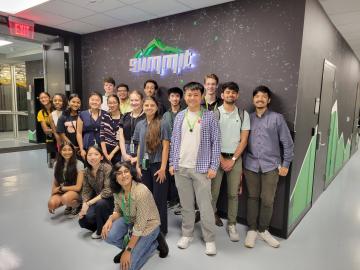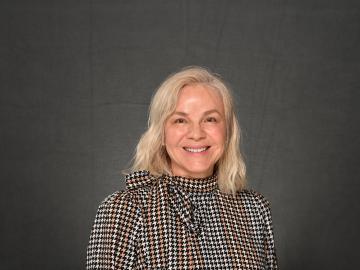Filter News
Area of Research
- (-) Biology and Environment (177)
- (-) Neutron Science (190)
- (-) Supercomputing (311)
- Advanced Manufacturing (34)
- Biological Systems (18)
- Biology and Soft Matter (5)
- Building Technologies (12)
- Chemical and Engineering Materials (4)
- Chemistry and Physics at Interfaces (11)
- Clean Energy (522)
- Climate and Environmental Systems (14)
- Computational Biology (6)
- Computational Chemistry (5)
- Computational Engineering (5)
- Computer Science (19)
- Data (1)
- Earth Sciences (1)
- Electricity and Smart Grid (3)
- Energy Frontier Research Centers (14)
- Energy Sciences (5)
- Fossil Energy (3)
- Fuel Cycle Science and Technology (3)
- Functional Materials for Energy (16)
- Fusion and Fission (54)
- Fusion Energy (17)
- Geographic Information Science and Technology (3)
- Isotope Development and Production (3)
- Isotopes (35)
- Materials (432)
- Materials Characterization (2)
- Materials for Computing (36)
- Materials Synthesis from Atoms to Systems (13)
- Materials Under Extremes (12)
- Mathematics (1)
- National Security (78)
- Neutron Data Analysis and Visualization (4)
- Nuclear Science and Technology (74)
- Nuclear Systems Modeling, Simulation and Validation (3)
- Nuclear Systems Technology (1)
- Quantum Condensed Matter (4)
- Quantum information Science (9)
- Reactor Technology (1)
- Renewable Energy (4)
- Sensors and Controls (5)
- Transportation Systems (11)
News Type
News Topics
- 3-D Printing/Advanced Manufacturing (17)
- Advanced Reactors (3)
- Artificial Intelligence (43)
- Big Data (26)
- Bioenergy (52)
- Biology (76)
- Biomedical (36)
- Biotechnology (14)
- Buildings (6)
- Chemical Sciences (15)
- Clean Water (13)
- Climate Change (51)
- Composites (5)
- Computer Science (107)
- Coronavirus (24)
- Critical Materials (4)
- Cybersecurity (9)
- Decarbonization (24)
- Energy Storage (17)
- Environment (109)
- Exascale Computing (24)
- Fossil Energy (1)
- Frontier (29)
- Fusion (2)
- Grid (7)
- High-Performance Computing (52)
- Hydropower (8)
- Isotopes (2)
- Machine Learning (20)
- Materials (36)
- Materials Science (38)
- Mathematics (3)
- Mercury (7)
- Microscopy (17)
- Molten Salt (1)
- Nanotechnology (24)
- National Security (9)
- Net Zero (3)
- Neutron Science (101)
- Nuclear Energy (8)
- Partnerships (5)
- Physics (17)
- Polymers (5)
- Quantum Computing (19)
- Quantum Science (29)
- Renewable Energy (1)
- Security (6)
- Simulation (23)
- Software (1)
- Space Exploration (5)
- Summit (46)
- Sustainable Energy (36)
- Transformational Challenge Reactor (1)
- Transportation (12)
Media Contacts

Scientists at ORNL have developed 3D-printed collimator techniques that can be used to custom design collimators that better filter out noise during different types of neutron scattering experiments

ORNL Environmental Sciences Division Director Eric Pierce presented the division’s 2023 Distinguished Achievement Awards at the organization’s December all-hands meeting.

A team of computational scientists at ORNL has generated and released datasets of unprecedented scale that provide the ultraviolet visible spectral properties of over 10 million organic molecules.

Research performed by a team, including scientists from ORNL and Argonne National Laboratory, has resulted in a Best Paper Award at the 19th IEEE International Conference on eScience.

This summer, ORNL welcomed more than 500 students to campus through the lab’s range of internship programs, which are offered in areas such as biology, national security and computing.

Researchers from institutions including ORNL have created a new method for statistically analyzing climate models that projects future conditions with more fidelity.

How do you get water to float in midair? With a WAND2, of course. But it’s hardly magic. In fact, it’s a scientific device used by scientists to study matter.

Four scientists affiliated with ORNL were named Battelle Distinguished Inventors during the lab’s annual Innovation Awards on Dec. 1 in recognition of being granted 14 or more United States patents.

Hilda Klasky, a research scientist in ORNL’s Computing and Computational Sciences Directorate, has been named a fellow of the American Medical Informatics Association.

ORNL's Climate Change Science Institute and the Georgia Institute of Technology hosted a Southeast Decarbonization Workshop in November that drew scientists and representatives from government, industry, non-profits and other organizations to




